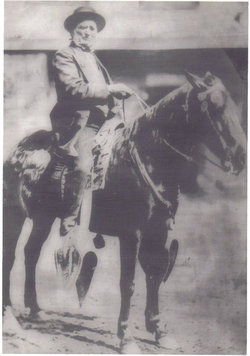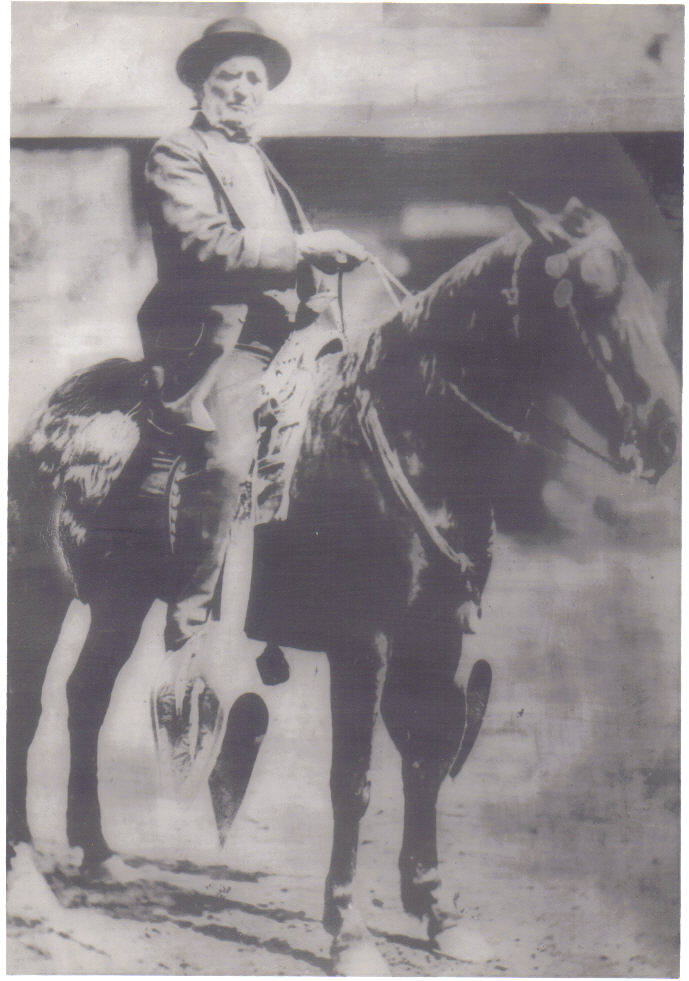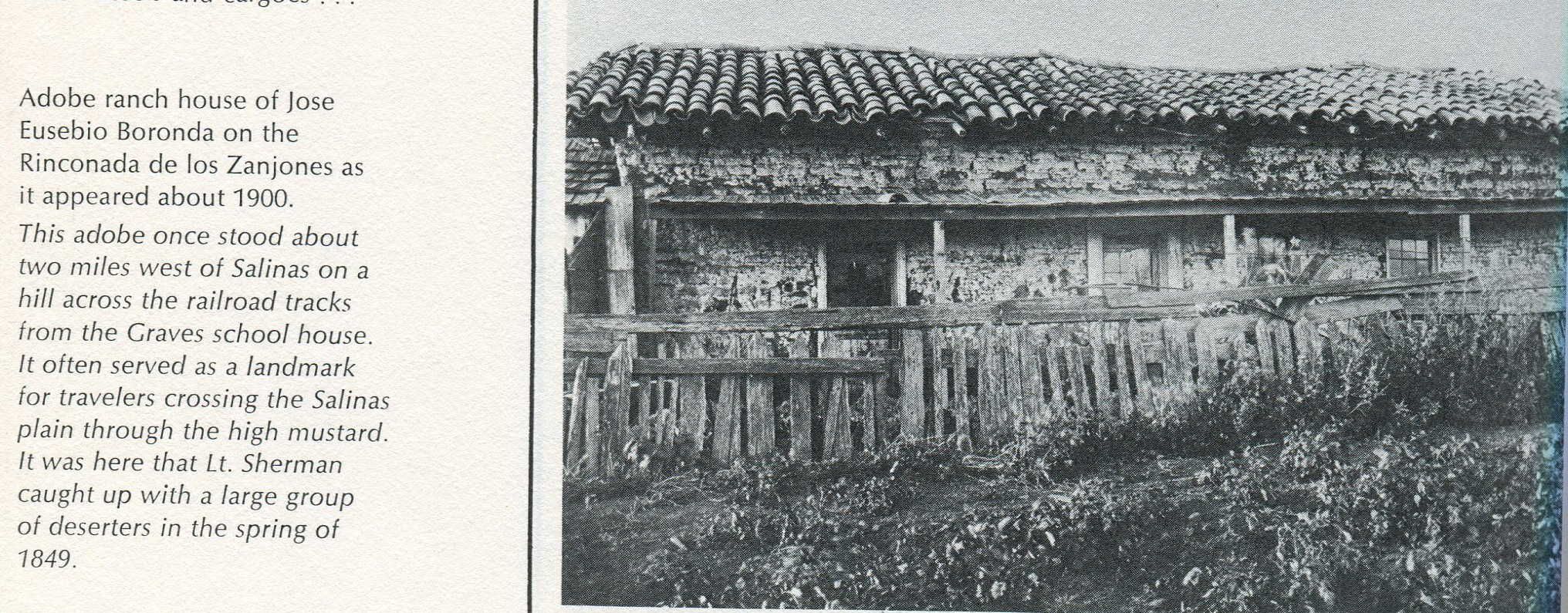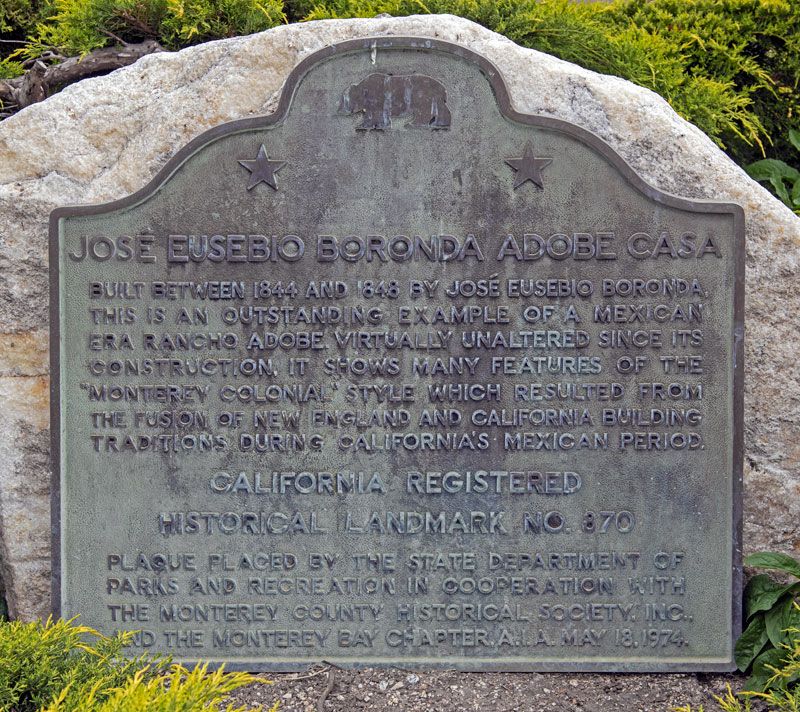Before striking out on his own, he married 14-year-old Josefa Ramona Buelna, September 5, 1831. He began a series of trades and ventures in the growing new industries, and by his thirties Eusebio had obtained a little land toward a home for his family of eight. His acquisitions peaked with a Mexican land grant of 6,700 acres, then began to dwindle as California became a state. He had fought with a militia of mounted Californios on Rancho La Natividad in the Salinas Valley against Fremont's occupation. Eusebio began the home for which he is most remembered, featuring extensive use of lumbar which he had traded for labor, unlike earlier brick adobes.
In his forties, a part time deputy judge and at the peak of his affluence, a series of legal actions over the years, together with his adult children's assertions and a possible melancholia, left his family and his holdings divided. He is absent from the family in the 1852 state census. These were turbulent times for the Spanish rancheros, their large land grants targeted by the new English speaking settlers, making claims hard to hold with the American civil codes and judges and juries now representing the new era.
He is listed as Jose B Boronda, a farmer on his $6000 property, in the Natividad section of Alisal Township, Monterey, 1860 U.S.census, age 53, with wife Josefa, 41, Francisco, 21, Maria, 18, Jose, 17, Arico, 14, Otoriano, 12, Dolores, 9, Carlotta, 7, Sylvano, 4, Ynez, 1, and a laborer from Mexico, Miguel, 35.
After Josefa Ramona's death, his children having grown up with the Americans, he settled for a forty-acre corner and built a smaller adobe. Another daughter, Josefita Boronda, born around December 2, 1866, after the death of his first wife, is shown on her epitaph as dying July 2, 1886, age 19 years and 7 months. He had remarried, to Ricarda "Carmine" Rodríguez, August 1, 1871, at the Santa Clara courthouse. Her daughter was married to his son, Francisco. They were last noted in the 1880 census, Eusebio as a 73 year old white farmer living with his 56 year old white wife, Carmine "keeping house", and his 16 year old daughter Rosa, with a 30 year old laborer/servant. It appears that Rosa and Josefita are the same, Eusebio's natural child between his marriages, living as Eusebio's and Ricarda's daughter. Inaccuracies on the 1886 epitaph, as he had called her Rosa for the census and "hija de Jose y Romana [sic] Boronda", suggests that Eusebio had died by then or was otherwise unable to attend to Rosa's burial. But with no information about their lives or deaths after 1880, they appear to have faded away with the era.
Ancestry.com has the date and place of death above in a member's family tree; it is plausible so now entered pending verification or refute. His wife's father had been born in San Luis Obispo so possibly she had family there to assist them his last year or two, Rosa grown by then and remaining in Salinas. Eusebio's older brother Canuto had a ranch there, dying two days later. [It's not unlikely that these two deaths might have been mixed in error.]
Before striking out on his own, he married 14-year-old Josefa Ramona Buelna, September 5, 1831. He began a series of trades and ventures in the growing new industries, and by his thirties Eusebio had obtained a little land toward a home for his family of eight. His acquisitions peaked with a Mexican land grant of 6,700 acres, then began to dwindle as California became a state. He had fought with a militia of mounted Californios on Rancho La Natividad in the Salinas Valley against Fremont's occupation. Eusebio began the home for which he is most remembered, featuring extensive use of lumbar which he had traded for labor, unlike earlier brick adobes.
In his forties, a part time deputy judge and at the peak of his affluence, a series of legal actions over the years, together with his adult children's assertions and a possible melancholia, left his family and his holdings divided. He is absent from the family in the 1852 state census. These were turbulent times for the Spanish rancheros, their large land grants targeted by the new English speaking settlers, making claims hard to hold with the American civil codes and judges and juries now representing the new era.
He is listed as Jose B Boronda, a farmer on his $6000 property, in the Natividad section of Alisal Township, Monterey, 1860 U.S.census, age 53, with wife Josefa, 41, Francisco, 21, Maria, 18, Jose, 17, Arico, 14, Otoriano, 12, Dolores, 9, Carlotta, 7, Sylvano, 4, Ynez, 1, and a laborer from Mexico, Miguel, 35.
After Josefa Ramona's death, his children having grown up with the Americans, he settled for a forty-acre corner and built a smaller adobe. Another daughter, Josefita Boronda, born around December 2, 1866, after the death of his first wife, is shown on her epitaph as dying July 2, 1886, age 19 years and 7 months. He had remarried, to Ricarda "Carmine" Rodríguez, August 1, 1871, at the Santa Clara courthouse. Her daughter was married to his son, Francisco. They were last noted in the 1880 census, Eusebio as a 73 year old white farmer living with his 56 year old white wife, Carmine "keeping house", and his 16 year old daughter Rosa, with a 30 year old laborer/servant. It appears that Rosa and Josefita are the same, Eusebio's natural child between his marriages, living as Eusebio's and Ricarda's daughter. Inaccuracies on the 1886 epitaph, as he had called her Rosa for the census and "hija de Jose y Romana [sic] Boronda", suggests that Eusebio had died by then or was otherwise unable to attend to Rosa's burial. But with no information about their lives or deaths after 1880, they appear to have faded away with the era.
Ancestry.com has the date and place of death above in a member's family tree; it is plausible so now entered pending verification or refute. His wife's father had been born in San Luis Obispo so possibly she had family there to assist them his last year or two, Rosa grown by then and remaining in Salinas. Eusebio's older brother Canuto had a ranch there, dying two days later. [It's not unlikely that these two deaths might have been mixed in error.]
Family Members
-
![]()
Jose Canuto Boronda
1792–1882
-
Jose Manuel Ciriaco Boronda
1793–1794
-
Maria Yrinea del Carmen Boronda
1795–1805
-
Maria Teresa de Jesus Boronda Soto
1797–1817
-
Josefa Bruna Boronda Burke
1799–1882
-
![]()
Jose Manuel Boronda Jr
1803–1878
-
Jose Francisco Laureano Boronda
1811–1811
-
Jose Francisco Laureano Boronda
1811–1811
-
Maria Petra de Jesus Boronda Martin
1812–1897
-
![]()
Maria Petra de Jesús Boronda y Higuera de Allen
1812–1897
-
Jose De Los Santos Boronda
1833–1837
-
Rafael Boronda
1834–1834
-
![]()
José Francisco Luís Boronda y Buelna
1836–1917
-
Maria Juana Boronda
1837–1839
-
Cirilo Jose De Jesus Del Carmen Boronda
1838–1838
-
![]()
Maria Dela Expection Boronda LeBaudour
1839–1927
-
Jose De Jesus Maria Boronda
1843–1918
-
![]()
Esiquio Maria Boronda
1846–1902
-
![]()
Jose Octaviano de Jesus Boronda
1847–1928
-
Carlota Boronda
1853–1864
-
![]()
Jose Sylvano Boronda
1857–1940
-
![]()
Maria Ynez "Agnes" Boronda Anderson
1859–1923
-
![]()
Josefita Boronda
1866–1886
Advertisement
Explore more
Sponsored by Ancestry
Advertisement





















